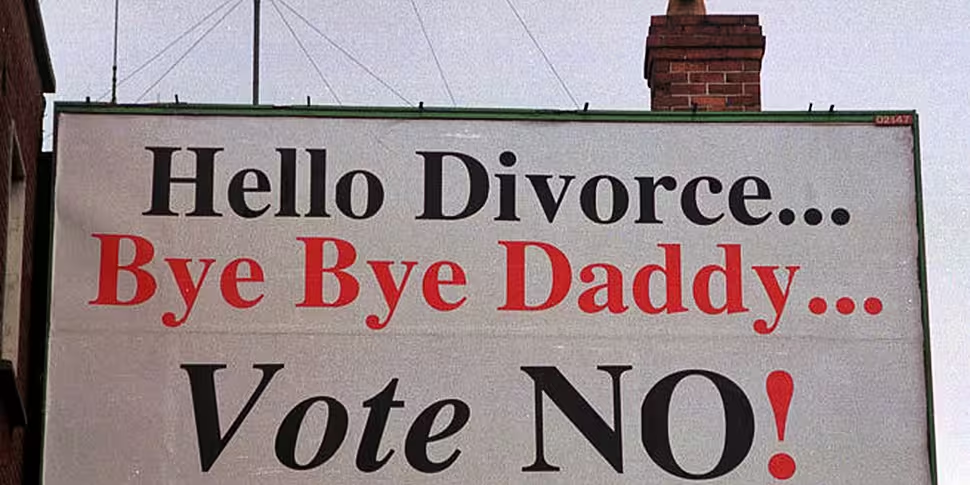Twenty years ago this week, the first divorce was granted in Ireland - an event seen as marking a major secular shift in Irish social views.
A divisive referendum on the issue in 1995 ended 58-year-old ban on divorce provided for in the 1937 Constitution, reading: "No law shall be enacted providing for the dissolution of marriage." It carried by the narrowest of margins - 50.28% to 49.72%.
As Catholicism remains the dominant religion in Ireland - with most recent Central Statistics Office (CSO) figures at 84% - and divorce rates here the third lowest in Europe - how has the societal view of divorce changed?

Brad Pitt and Angelina Jolie - one pair of 2016's high profile divorcees
The campaigns
The coalition government of Fine Gael and Labour announced the wording of the proposed divorce amendment on September 13th 1995. There was a show of coalition solidarity as the referendum campaign effectively got underway.
As part of the amendment, couples would have to prove there was no hope of reconciliation, that they were living apart for four of the five years and that adequate provision is being made for spouses and children. It would also allow for remarriage.
At the time, Tánaiste Dick Spring said at a press conference, "The Government is convinced that to continue to deny such a right would represent a grave injustice to many thousands of individuals. That is why we will be asking the people of Ireland on Friday November 24th to decide in favour of change, to remove the constitutional ban on divorce, and to replace it with a carefully considered wording.

Labour leader and Tanaiste Dick Spring at a Labour Party divorce campaign press conference in the Shelbourne Hotel. Image: RollingNews.ie
RTÉ reported at the time that Law Reform Minister Mervyn Taylor said the government was not introducing a "divorce culture", while Taoiseach John Bruton predicted the referendum's passing.
The Church of Ireland's stance wasn't a million miles away from that of the Government, and while seemingly not seeking to encourage 'divorce-on-demand', they saw divorce as something that would "make an unsatisfactory situation a little bit more satisfactory".
"The Church of Ireland teaching is for the total commitment and the lifelong marriage relationship", he said. "However, it is so obvious in recent years that marriage has broken down, separations all over the place, and we feel something must be done [..[ And we feel this is the only road," Dr Walton Empey said in a statement.
In 1995, the Church of Ireland had 90,000 members in the 26 counties.
Across the pond, the New York Times reported on the divorce referendum, calling it "a rare clash between the leaders of its Government and those of its church".
"In their [the Catholic Church's] statement, the bishops appeared to be changing tactics", the article reads. "In 1986, the church emphasised the problems divorce would create in property rights. The Government later established procedures for dealing with property. This time, the bishops argue that "any undermining of the meaning of he marriage promise would profoundly damage the stability of society," without mentioning property."

File photo of Cahal Daly. Image: RollingNews.ie
Cardinal Cahal Daly said the issue was "over to the consciences of the voters" but did not say Catholics who did not vote against divorce would be committing a sin.
The No campaign succeeded in creating one of the most memorable billboards possibly of all time. "Hello Divorce... Bye Bye Daddy... Vote no!" An argument was put forward that Irish men would leave women in their droves.

The vote
Irish people took to the polls on November 24th 1995.
A total of 818,842 people voted Yes and 809,728 voted No. 5,372 ballots were spoiled.
Wet weather that dampened turnout in the west of the country was credited with reducing the extent of the No vote.
Geographically, the breakdown was significant The Yeses were strongest in Dublin, Kildare and Wicklow. Other counties in favour included Cork South Central, Louth, and Limerick East, where there were only 44 votes between the sides. The rest of the country voted No.
Dún Laoghaire had the highest Yes vote, at 68 per cent, while in Cork North West, nearly always one of the most conservative districts in the country, the vote was 34 per cent, the lowest in the country.
Dun Laoghaire pier. Image: Flickr
The aftermath
In 1997 the first divorce orders came through, with the courts granting 95 decrees in total
Initially, the uptake on divorce was slow. However, the The Irish Times reported a surge in divorce between 1997 and 1998.
3,000 people sought divorces in the courts in the 10 months of the legal year which ended on July 31st, 1998. The number of people seeking a legal exit from their marriages - including applications for declarations of nullity and judicial separations - rose to 4,327 in the 1998 legal year, a massive jump from 1,728 in 1997.
This compares with just over 400 in the five months between the coming into force of the Divorce Act in February 1997 and the end of the 1997 legal year - a 350% increase in a year.
Each county saw applications made, though inevitably the largest numbers came from Dublin and Cork, with 1,277 and 268 made respectively.
In 2016, Newstalk reported that Ireland continued to boast one of the lowest divorce rates in Europe at 0.6 per 1,000 population.

Image: CSO
The impact
Speaking on Newstalk Breakfast, sociologist Dr Paul Ryan of Maynooth University said it cannot be underestimated just how contentious the issue was.
"It was coming at a very interesting time around Irish social life", he said. "We were coming off the back of Mary Robinson's selection in 1990, the decriminalisation of homosexuality and the birth of the Celtic Tiger. There was this kind of movement towards a more secular, liberal society.
"We were seeing the church was going to be mired by continuing child sex abuse allegations [...] It was the last time we saw the church really be more active in these types of referenda."
Contrary to the No campaign at the time, research also shows that women are 55% more likely to initiate divorce in Ireland.
According to Dr Ryan. campaigners for marriage equality took inspiration from the battle for divorce rights.
"People kind of pointed back and said look, the sky didn't fall in, the Irish family is a pretty robust institution, people are very committed to the idea of family. We can do gay marriage - there's not going to be a huge impact."

Yes campaigners living and working abroad campaigned online and on social media
What's next?
A 'quickie' divorce referendum could be held in the future.
Josepha Madigan, a Fine Gael TD, proposed reducing this to two years. Support for her private member’s bill is gaining momentum in Leinster House.
“I’m encouraged by what people are saying to me,” said Madigan, a family-law solicitor. "The taoiseach and frances Fitzgerald [the justice minister] are supporting it. I have spoken to them both."
Minister for Social Protection Leo Varadkar is also backing the bill. "It's something we'll have to discuss around the cabinet table but I think there's a lot of merit."
The Sunday Times claims a lack of opposition to the changes could mean that the country votes on divorces again before voting on abortion.
Labour Senator Ivana Bacik says long waiting times for divorces were strategic.
"It was seen as a way of ensuring the Divorce Referendum [in 1995] passed", she said. "Many of us, especially lawyers had real issue at the time with this - that it was placing this unnecessary hurdle right into the constitution."
Iona Institute director David Quinn said the Catholic think-tank is not opposed to the bill.










